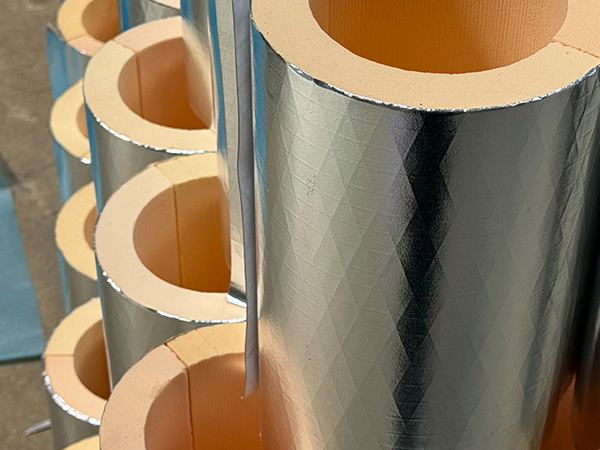
Phenolic foam thermal insulation pipe shell for pipeline insulation
Phenolic foam thermal insulation pipe shell is a high-performance solution designed for efficient thermal management in industrial, commercial, and HVAC piping systems. Manufactured from rigid phenolic foam, it provides superior insulation, fire resistance, and durability, making it ideal for both hot and cold pipeline applications.
Key Features & Benefits
1. Outstanding Thermal Performance
Ultra-low thermal conductivity (0.020–0.025 W/m·K) – Minimizes heat loss/gain for energy-efficient operation.
Stable temperature maintenance – Ensures consistent thermal protection in extreme conditions.
2. Fire-Resistant & Safe
Class A fire rating – Self-extinguishing with low smoke emission.
Non-toxic combustion – Safe for indoor and confined spaces.
3. Moisture & Corrosion Resistance
Closed-cell structure – Prevents water absorption (<1%) and eliminates corrosion under insulation (CUI).
Chemical resistance – Withstands exposure to oils, mild acids, and alkalis.
4. Lightweight & Durable
High strength-to-weight ratio – Easy to handle yet durable under mechanical stress.
Long service life – Resists aging, mold, and degradation.
5. Easy Installation & Maintenance
Pre-fabricated shells – Custom-fit for pipes, valves, and fittings.
Split design – Simplifies installation and allows for maintenance access.
Applications
✔ Industrial pipelines – Oil & gas, chemical plants, power stations.
✔ HVAC systems – Chilled water, steam, and condensate lines.
✔ Refrigeration systems – Cold storage and cryogenic pipelines.
✔ District heating networks – Energy-efficient hot water distribution.
Technical Advantages
Operating range: -40°C to +120°C
Compressive strength: ≥150 kPa
Custom thickness: 20–100mm
Standard diameters: 15–600mm
Why Choose Phenolic Foam Pipe Shells?
Energy savings – Reduces heat loss by up to 30% compared to traditional insulation.
Fire safety – Meets stringent fire protection standards.
Low maintenance – Long-lasting performance with minimal upkeep.
Space-efficient – High R-value allows for thinner insulation layers.
Installation Guidelines
Measure pipes – Ensure accurate dimensions for a perfect fit.
Select thickness – Choose based on thermal requirements.
Secure shells – Use high-temperature adhesive or mechanical fasteners.
Seal joints – Apply foil tape or mastic for airtight insulation.
Conclusion
Phenolic foam thermal insulation pipe shells provide optimal thermal protection, fire safety, and durability for critical pipeline systems. Their lightweight design and superior performance make them an excellent choice for energy-efficient and long-lasting insulation solutions.
Contact us for custom specifications or bulk orders!
Note: Performance may vary based on installation quality and operating conditions. Always follow manufacturer guidelines.
How Phenolic Pipe Insulation Section Controls Condensation and Protects Pipelines
Learn how Phenolic Pipe Insulation Section stops pipeline condensation and improves energy efficiency. Discover the science behind phenolic insulation, its performance benefits, and why choosing a reliable phenolic insulation manufacturer in China or Chin
2025-11-02
Thermal Insulation Cotton Explained: How It Retains Heat
Learn how thermal insulation cotton works to retain heat and save energy. Explore its science, benefits, and the advantages of sourcing in bulk from a trusted Chinese manufacturer and supplier.
2025-10-30
Rubber Foam Board Installation Guide: Key Issues and Practical Fixes
A complete guide to installing rubber foam boards efficiently. Explore common installation problems, expert fixes, and the benefits of sourcing high-quality rubber foam insulation in bulk from a reliable Chinese manufacturer.
2025-10-29
What Is Sound Insulation Cotton and How Does It Work?
Learn everything about sound insulation cotton — its composition, working principle, and wide applications in noise reduction. Discover the benefits of sourcing bulk acoustic insulation cotton directly from a reliable Chinese manufacturer.
2025-10-27



